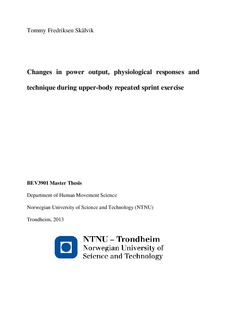| dc.description.abstract | Purpose: The purpose of this study was to examine upper-body repeated sprint performance, physiological responses, and the relationships to technique and muscle co-ordination.
Methods: Twelve male elite cross-country skiers (body mass: 75.4 ± 7.1, VO2max: 73 ± 4) were tested for repeated sprint ability during 8·8-s maximal poling with 22-s breaks sprint using a modified poling ergometer. Total mean power (i.e. mean power of all sprints added together) and the sprint decrement (i.e. difference in percent between total mean power and best single sprint power times 8) determined performance. Applied forces were measured with a force cell, the movement frequencies and velocity of the movement using high-speed infrared cameras, muscle activation by surface electromyography of biceps and triceps, oxygen consumption was continuously measured breath by breath and blood lactate in the breaks between each sprint. Furthermore, peak power was determined from the first 8-s sprint and VO2peak during a 3-min all-out ergometer poling test.
Results: The average total mean power was 2246 ± 387 W. The average sprint decrement was 11.7 % after eight sprints. Poling rate did not change, while power per stroke decreased during the eight sprints (p<0.05). Activation of biceps brachii increased- and triceps brachii decreased during the repeated sprint exercise, however these changes did not correlate with the changes in performance. Furthermore there was a change in the timing of the triceps in the last two sprints. The greatest increase in VO2 occurred between sprint 1 and sprint 2 (p<0.05), after which the increase plateaued at a level of 75% of VO2peak. VO2peak during a 3-min all-out poling test correlated with power per stroke in the last three sprints (r = 0.6 – 0.7, all p<0.05). Total increase in blood lactate correlated with total mean power (r = 0.692, p<0.05) and sprint decrement (r = 0.604, p<0.05).
Conclusions: During repeated sprint exercise with 22-s breaks a high decrement in power is apparent after the first sprint. The changes in power are related to reduced power per stroke, without any changes in poling rate over all eight sprints. The change in muscle activation suggests an alteration of technique during the two last sprints in order to withstand fatigue. VO2peak seems to be important in the latter stages of RSE. Increase in lactate is a fatiguing factor related to sprint decrement, however a large increase in lactate also seems to cause high total mean power, suggesting that the ability to enable lactic energy sources enhances high power outputs.
Key Words: Repeated sprint ability, upper-body, performance, poling, kinematics, VO2, Lactate | nb_NO |
